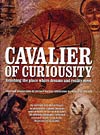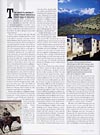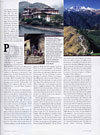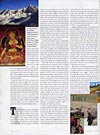Eccentric Explorers :: Sample Text
Eccentric Explorers: Magazine Feature
Shortened and modified versions of several profiles from the book have been published in magazine sources. The following feature is a brief profile of explorer Michel Peissel, published in NUVO Magazine, Canada.





CAVALIER OF CURIOSITY
Reaching the place where dreams and reality meet
An interview with Michel Peissel, unconventional explorer, inventor, anthropologist, writer, photographer, documentary filmmaker, television presenter, dealer in mysteries, discoverer of lost worlds…
by Michael Buckley
Michel Peissel ushers me into the apartment and offers me a seat—but does not sit down himself. He is on the move, even in his own living-room. He chats excitedly about his new projects. The phone rings. A courier has come to pick up a video Peissel has just finished editing. The phone rings again. He answers in French. "That's my girlfriend," says Peissel casually. "Soon to be my wife." I look at him quizzically. "My third wife."
At 65, Peissel shows no sign of slowing down—or indeed, of even sitting down. He dashes off into the adjacent study. "Oh and here's my new baby," he says, grinning from ear to ear. It's a hardcover book, Tibet: the Secret Continent, hot off the press. It is the fruit of Peissel's expeditions to the Tibetan Plateau—some 30 of them in the last 20 years—handsomely illustrated by his own photographs. He flips to a page showing stone towers in southeastern Tibet. "These towers are a mystery. In the middle of nowhere. Some are over 50 metres high," he says. "Nobody knows what they are doing there, or who made them." He goes into his study and returns with a drawing. "And here's another mystery. This is a sketch I made from an amulet in Lhasa. The design is very similar to those of the ancient Scythians, from the Black Sea area, who worshipped griffins. But who were the Tibetan artisans who kept alive an artistic tradition that disappeared everywhere else 2,000 years ago? I have yet to find the answer."
Michel Peissel is dealer in mysteries. He is renowned as an explorer—though he will tell you otherwise, because he hates pigeonholing. In the 21st century, you'd think that the planet has been thoroughly explored and picked over, and that explorers are redundant. But in the grand old 19th-century tradition of exploration, Peissel's quest goes on. "I prefer to be called an adventurer," says Peissel. "Essentially, I am just a very curious person."
That would be putting it mildly: Peissel embraces a broad range of interests. He loves solving riddles, especially geographical and historical ones. His intense curiosity has driven his entire life. "Very few people receive grants for curiosity," notes Peissel, wryly—but he seems to have managed the feat. So how do you become an explorer? By accident, he claims, though he always fantasised about it.
The son of a French diplomat, Michel Peissel was raised in England and France. Due to his father's posting in London, Peissel learned English before French—he writes most of his books in English. His childhood heroes were great explorers and adventurers. He initially studied to become an economist: his life went off at a tangent when he took time out from Harvard Business School to visit Mexico in 1958. His "spring break" was a little different: one night, he and a fellow European decided to set off along the uncharted coast of eastern Yucatán. His companion turned back when the going got tough, but Peissel forged on, chartering a native craft, and then, finding himself stranded, walking in sandals for 42 days—along the coast normally only visited by smugglers. The young adventurer stumbled across 14 unrecorded Mayan archeological sites—quite a feat for someone with no experience in exploration. Peissel was just 21 at the time: the trip changed his life. It told him that the planet was still exciting and mysterious—and there were many secrets to uncover. Peissel's Yucatán journey resulted in his first book, The Lost World of Quintana-Roo (1963) and sparked a lifelong interest in Mayan coastal culture: he has returned several times on expeditions.
PEISSEL'S UPBRINGING IN A diplomat's family stood him in good stead for dealing with bureaucrats: he has an uncanny ability to charm his way past officials and wrangle permits for sensitive areas. His talent for languages has helped considerably—he speaks fluent English and French, and has mastered Spanish and Tibetan. For his PhD thesis, he switched to the Sorbonne in Paris, in the field of ethnology—and came up with a startling study area. In the early 1960s, Peissel found himself in Kathmandu, Nepal. Originally he had his heart set on visiting the remote Kingdom of Bhutan, but was unable to get permission to enter. But persistence is Peissel's game: he turned his attention instead to the tiny Kingdom of Mustang in the Nepal Himalayas, bordering Tibet.
Getting to Mustang was not easy. Peissel had arrived at a time when Khampa guerrillas from eastern Tibet, backed by the CIA, were using Mustang as a base to launch raids on Chinese troops in western Tibet. Peissel had trouble finding caravan companions for the journey to Mustang because the Nepalese feared the tall brawny Khampas, who had a reputation for being ruthless brigands. Peissel ran into a number of Khampa groups on his expedition. His knowledge of Tibetan helped smooth things over, but more than once he found himself looking into the muzzle of a sub-machine gun. He eventually made friends among the Khampas and developed great respect for them.
Dressed in a Tibetan sheepskin coat and speaking Tibetan, Peissel was able to trek into the Kingdom of Mustang, staying for several months in the summer of 1964. Very few Westerners had penetrated the remote region: none had stayed long enough to research its culture and history. Peissel found a walled citadel, locked in a medieval timewarp, ruled by a lineage of kings stretching back to the 14th century. With the wealth of material he collected, Peissel not only completed his doctoral thesis, he landed a cover story for National Geographic in 1965. This was followed in 1969 by the publication of Mustang: A Lost Tibetan Kingdom, which went on to sell several million copies in France and won several prestigious awards. All this launched his dream of devoting his energy to exploration by giving him credibility—and a financial base.
Spurred by his early success, Peissel mounted more expeditions to hidden enclaves and kingdoms on the Tibetan Plateau on horseback. "I felt a special kinship with Tibetan peoples and their customs—their basic humour and broad-mindedness. I even started to dream in Tibetan." Expeditions to Ladakh and Zanskar were followed in 1968 by a journey to his dream destination of Bhutan. At the time, there were few roads in these regions: getting around was mostly accomplished on foot or on horseback, with pack-animals carrying supplies. Peissel was the first foreigner to explore the eastern reaches of the reclusive Buddhist kingdom of Bhutan.
But Tibet itself eluded Peissel—because of a book he wrote. It was a spin-off from his Mustang trip—a book called The Cavaliers of Kham, published in 1972. This book, about Tibetan Khampa guerrillas operating in Mustang with CIA support, became a bestseller—and it got Peissel into lots of trouble. In the book, Peissel detailed China's genocidal policies in Tibet, and systematic destruction of monasteries, and although he was tight-lipped on CIA backing for the Khampas, it was enough to provoke considerable reaction. "The Chinese were furious with me—they banned me from visiting China. I upset the Americans—they were angry about this story leaking out. And I upset the Nepalese. But to the Tibetans I was a hero because I spoke up about the plight of the Tibetans—and at that time, nobody was doing that." Peissel was blacklisted in China, which meant he was barred from reaching Tibet.
Peissel's book was published before the final chapter could be written—the betrayal of the Khampa guerrillas, who were snuffed out by Nepalese forces in 1974 under Chinese pressure: all the Khampas were either killed or captured. Because of its political sensitivity, soon after Peissel's visit, Mustang was closed down to outsiders—for over 25 years. When it re-opened in the early 1990s, Peissel made a trip back to Mustang on horseback. I was among those who later trekked in: Peissel's book on Mustang was my inspiration and my guide. Little seemed to have changed since the book was first printed: in fact, the king still ruled over the tiny kingdom, and Peissel's key contact in Mustang—a man called Pemba—was still there, running a small shop.
Now all material on the Khampa guerrillas and CIA is declassified, leading to a recent flurry of publishing, with some titles authored by former CIA operatives. The books essentially back up what Peissel wrote about 30 years ago. Meanwhile, Peissel fictionalised the setting by writing two novels in French—La Tibétaine (1989) and La Khamba (1996)—which have been optioned as Hollywood movies.
—the full profile on Michel Peissel can be found in the book Eccentric Explorers.
Michel Peissel died of a heart attack in Paris, on October 7, 2011, at the age of 74. On the day he died, he had tickets to travel to Frankfurt Book Fair to promote his latest book, said his wife, Roselyne Peissel. "Travel with him was always a triumph over the impossible," said one of his sons, Olivier, a sometime travel companion.

This material © copyright Michael Buckley. All rights reserved.